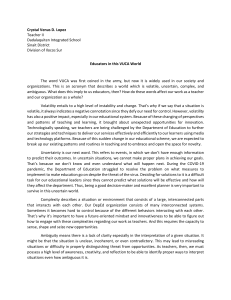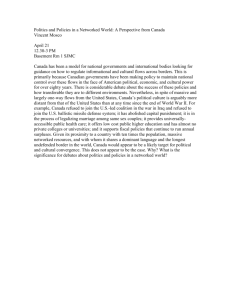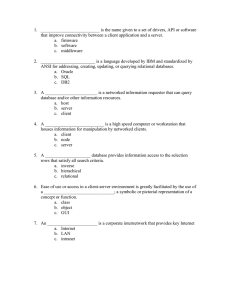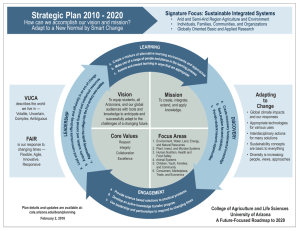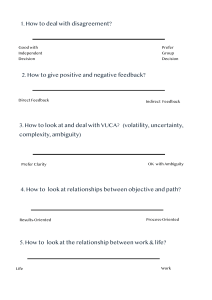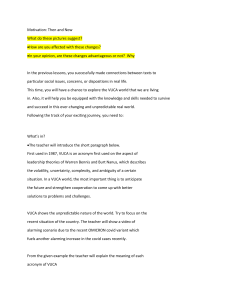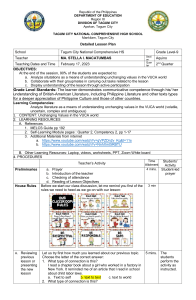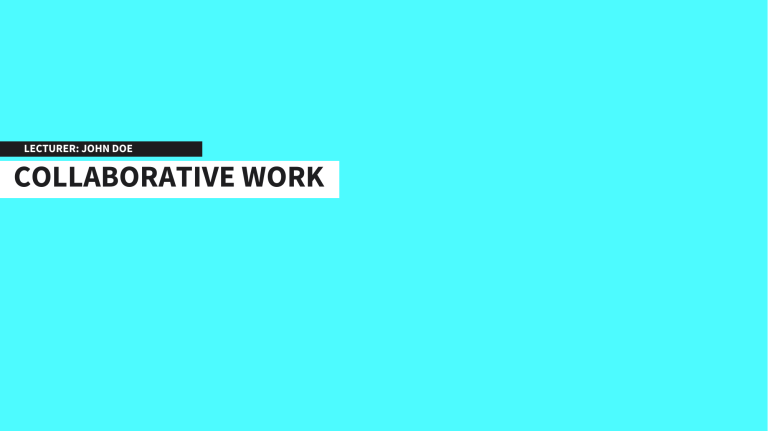
LECTURER: JOHN DOE COLLABORATIVE WORK INTRODUCTORY ROUND Who are you? - Name Employer Position/responsibilities Fun Fact Previous knowledge? Expectations? COLLABORATIVE WORK TOPIC OUTLINE Learning for a Networked World, in a Networked World 1 Networking & Cooperation 2 Performance in (Online) Teams 3 Communicating and Convincing 4 Recognizing Conflict Potential — Managing Conflicts — Negotiating Effectively 5 COLLABORATIVE WORK TOPIC OUTLINE Achieving Your Goals 6 Mobilizing Resources 7 8 9 10 UNIT 1 LEARNING FOR A NETWORKED WORLD, IN A NETWORKED WORLD STUDY GOALS - Understand specific demands of the networked world and their opportunities. - Successfully handle information, knowledge, and lack of awareness in purposeful and productive ways. - How learning processes can be actively and constructively designed. - How to analyze and further develop your own learning behavior. EXPLAIN SIMPLY 1. Explain the acronym VUCA. 2. Delimit the terms data, information and knowledge. 3. Which factors influence how well learning works? LEARNING FOR A NETWORKED WORLD, IN A NETWORKED WORLD Requirements and opportunities in the “VUCA” world Learning, knowledge, and the unknown The 4C-model: Collective, collaborative, continuous, and connected Improving learning behavior VUCA – Dealing with the unexpected and incalculable Volatility - inconsistency - potential for change Source of the text: Burg, 2017. Uncertainty - risk - incertitude - the unknown Complexity - unpredictable - multi-layered Ambiguity - equivocation - opacity COMPLEXITY-SPECIFIC DECISION-MAKING WITH THE STACEY MATRIX - Obvious situations UNKNOWN In the simplest case, everything is obvious, known and clear. - There is a variety of connections and possibilities for action. - Complex situations WHAT - Complicated situations CHAOTIC COMPLEX DEMAND - COMPLICATED is no longer useful. - Chaotic situations - Objectives, tasks’ consequences and procedures are - uncertain. A methodical approach is no longer appropriate. Source of the graphic: Sauter et al., 2018, p.8. CLEAR - If there is ambiguity and uncertainty, variance test control OBVIOUS KNOWN EXECUTION HOW UNKNOWN LEARNING FOR A NETWORKED WORLD, IN A NETWORKED WORLD Requirements and opportunities in the “VUCA” world Learning, knowledge, and the unknown The 4C-model: Collective, collaborative, continuous, and connected Improving learning behavior LEARNING AND MEMORY Learning and memory are two sides of the same coin: Learning refers to either the acquisition of information or motor skills. Memory refers to the application of information. SHORT- AND LONG-TERM MEMORY – Information always initially enters the short-term memory. – It stays there for several seconds or a few minutes, e.g.: a phone number that you remember long enough to write down. – If the information receives close attention, it enters the long-term memory. Source of the graphic: Brand & Markowitsch, 2009, p. 70. CONSOLIDATION (REINFORCEMENT) AND STORAGE MEMORY CONTENT CREATION AND RETRIEVAL CONSOLIDATION DEPOSITION RETRIEVAL Source of the graphic: Brand & Markowitsch, 2009, p. 72. RE-ENCODING STORING DATA, INFORMATION, AND KNOWLEDGE Data Observation Instruments Relevance Filters Biological instruments Technical instruments Intellectual instruments (theories, etc.) Source of the graphic: Zeuch, 2007, p. 16. Information Knowledge LEARNING FOR A NETWORKED WORLD, IN A NETWORKED WORLD Requirements and opportunities in the “VUCA” world Learning, knowledge, and the unknown The 4C-model: Collective, collaborative, continuous, and connected Improving learning behavior THE 4C-MODEL: COLLECTIVE, COLLABORATIVE, CONTINUOUS, AND CONNECTED Framework for collaborative learning - Learning is about using ideas, experience, and knowledge from all relevant sources to achieve high productivity and innovation. Collective Source of the text: Sauter et al., 2018, p. 243. - - Through cooperation amongst learners and between learners and teachers, new knowledge is created. Social learning exists on learning from and with others. Collaborative - - We learn every day in a continuous cycle of development and communication. Learning no longer takes place sporadically in institutionalized settings such as seminars or at schools. Continuous - Learning takes place independently of a location or a terminal, i.e., exactly where it is necessary. Connected 4C-MODEL: BASIC DIGITAL SKILLS ARE INDISPENSABLE FOR LEARNING Digital Literacy Digital Interaction Collaboration Agile Work Digital Learning Digital Ethics Source of the text: Kirchherr et al., 2018, p. 6. the mastery of basic digital skills, e.g., careful digital personal data, common software knowledge, AI interaction the use of appropriate tone and candor on online forums the effective and efficient use of digital tools regardless of physical proximity and across different disciplines and cultures in order to achieve better results as a team than as an individual the iterative work of a team responsible for a product (“Rapid Prototyping”) that adds value for the customer the deepening of knowledge on selected topics from a variety of digital resources the critical questioning of digital information and the effects of one's own digital actions to make corresponding ethical decisions HOW WELL LEARNING WORKS DEPENDS ON Motivation Attitude It is helpful - if you are personally interested in what there is to learn. - if you find sense in knowing or being able to know it. - An enthusiastic mood and a moderate level of energy is conducive to learning. - i.e., not too relaxed but not too tense Environment Affect - Your attention should not be divided. - Interestingly, no convincing proof has been found that multitasking really works. - When two activities, requiring equal cognitive attention, are performed at the same time, the focus jumps quickly from one activity to the other. - It is beneficial to learning if the relationship and interaction with fellow learners fosters a cheerful mood and bolsters your interest. Source of the text: Roth, 2009, pp. 58-68. LEARNING FOR A NETWORKED WORLD, IN A NETWORKED WORLD Requirements and opportunities in the “VUCA” world Learning, knowledge, and the unknown The 4C-model: Collective, collaborative, continuous, and connected Improving learning behavior BRAIN-FRIENDLY LEARNING ELEMENTS Identify the essentials Get overview of learning units Create experience-rich discussion basics Brand & Markowitsch, 2009, pp. 69-85. Create a personal learning structure Create a personal frame of reference Identify previous knowledge and associations Create positive emotions EXCURSUS: HOW THE BRAIN WORKS Source: Youtube, 2018. REFLECTION - Basis for autonomy and selfdetermined action - Reflection enables to question the actions, values, and assumptions you hold to check your learning success. - What has been learned is further reinforced and deepened. - Through reflection you can take stock of the learning process as a whole, as well as its application, and assess its value. Source of the graphic: Hummelbrunner & Reynolds, 2013, p. 2. TRIPLE-LOOP LEARNING DOUBLE-LOOP LEARNING SINGLE-LOOP LEARNING Are we doing things right? INTERVENTION EFFECTS Are we doing the right things? PERSPECTIVES What makes this the right thing to do? BOUNDARIES INTERRELATIONSHIPS QUESTIONS, PURPOSE, GOALS POWER FOR DETERMING PURPOSE AND GOALS REVIEW STUDY GOALS - Understand specific demands of the networked world and their opportunities. - Successfully handle information, knowledge, and lack of awareness in purposeful and productive ways. - How learning processes can be actively and constructively designed. - How to analyze and further develop your own learning behavior. UNIT 1 TRANSFER TASK TRANSFER TASK Test on own learning behavior Put it to the test: How professional is your learning behavior already? TRANSFER TASK Tick the statements that apply to you. q Before I start learning, I make it clear to myself what I want to achieve - and can then focus on the q q q q q q q q q q essentials. I think about how what I want to learn can benefit me in everyday life. I can motivate myself well. I make sure that I am concentrated. I plan my time so that I do not come under (noticeable) pressure. I also plan breaks in a targeted manner. I always get an overview of the material first - and set priorities according to my objectives. I make clear to myself what I already know about the topic and what associations I have with it. I plan the individual learning tasks and learning steps and (largely) stick to my planning. I pay attention to the structures and connections of the material - and recognize them. I structure the individual learning contents - summarize them in keywords or create mind maps. TRANSFER TASK q When I study for exams, I get familiar with the requirements beforehand. q For exams, I solve sample exams. q For homework/seminar papers, I read the guidelines with the requirements carefully. q I use mnemonic devices to help me remember facts. q I study with suitable learning partners. q I study more extensive topics with different sources of knowledge. q I have a system for systematically repeating what I have learned. q I reflect on my learning process - especially after exams I do my own "success control": How was my q q effort and approach - what did I achieve? And learn from it... I reflect on my ignorance - and realize my own errors, prejudices and possible half knowledge. I also reflect on ways to improve my own learning processes with appropriate learning partners . TRANSFER TASK Evaluation For the overall evaluation, how many crosses did you make? < 10: You are already implementing a few learning strategies - but there is still plenty of room for improvement. 10 - 14: You are already on the right track. Three or four more points - and you will use your learning energy and time much more effectively and efficiently. 15 - 19: You are already planning and designing your learning processes quite professionally - you can still optimize in one or two areas. 20 and more: You are a learning strategy professional. Think about how you can continue to learn as effectively and efficiently in the future. TRANSFER TASK Open questions Take a closer look at the individual statements: - In which areas are you already fit? - Where do you still need to improve? TRANSFER TASK PRESENTATION OF THE RESULTS Please present your results. The results will be discussed in plenary. LEARNING CONTROL 1. Which statement on the requirements of a VUCA world, characterized by volatility, uncertainty, complexity, and ambiguity, is correct? a) Even in a VUCA world, not everything is “complex”; instead, there are more or less b) c) d) complicated, complex or chaotic situations in which different principles of action and decision are appropriate. In the VUCA world, all situations are fundamentally complex and no action is possible following proven rules and patterns. Volatility, uncertainty, complexity, and ambiguity are not new phenomena; therefore, strictly speaking, there are no real new challenges today compared to the past. According to the Stacey-Matrix, every situation can be assigned to an appropriate principle of action; therefore, in the VUCA world, reliable forecasts and decisions can ultimately always be made. LEARNING CONTROL 2. Which of the following approaches most effectively supports learning and memory? a) Information should be stored separately and should not be mixed with other information b) c) d) or memory content, as this would impede later recall. According to Hebb’s learning rule (“Cells that fire together, wire together”), it is important to perform as many different activities as possible at the same time and to learn in an environment that offers as many sensory stimuli as possible so that diverse connections are created in the brain. Combining individual data into groups or categories makes it easier to store new information and retrieve it later. If you want to remember what you have learned (e.g., for an exam), it is important to search only for the individual technical terms and ignore how and in what situation you have learned. Only in this way is required open recall possible. LEARNING CONTROL 3. Which statement about the unknown is correct? a) Taboos should always be respected unquestioningly as effective means of reducing b) c) d) complexity. The mistaken belief that one knows or has the ability to know something (error) presents a double obstruction: first, it filters out what is relevant inhibiting the recognition of new, important information; secondly, it ensures that further errors arise because new information is “reconstructed” in such a way that it could be connected to the error. Errors are not a problem in the learning process in that they can be easily resolved by new information. Ultimately, any form of ignorance leads to a loss of power to act; therefore, it is not possible to act competently without complete knowledge. LEARNING CONTROL 4. What has to be considered when designing learning processes? a) It is important to identify which type of learner you are (auditory, visual, kinesthetic) and b) c) d) to consider this while learning. It is advantageous not to make any personal reference to the subject matter; otherwise, the mind work will be affected by emotions. Sustained engagement as well as a positive emotional connection with the material is essential to learning. Although reflection is important when assessing learning material, it ultimately obstructs the reinforcement and embedding of what has been most recently learned, as this new knowledge is being questioned through critical reflection and cannot be so easily consolidated. LEARNING CONTROL 5. What is a particularly promising approach to exam preparation? a) It is effective and efficient to first look closely at the examination requirements, get an b) c) d) overview of the subject matter, and draw up a learning plan based on this assessment. Effective and efficient exam preparation always begins with learning the subject matter as comprehensively and thoroughly as possible, followed by an gaining an overview of the exam requirements. For both homework and seminar work, it is important to work through the entire learning material thoroughly and memorize as much as possible because the learning material always forms the basis of further work. Ultimately, the best exam preparation is always to learn the whole material by heart as systematically as possible, e.g., with the help of a flash card system. LIST OF SOURCES Brand, M. & Markowitsch, H. J. (2009). Lernen und Gedächtnis aus neurowissenschaftlicher Perspektive: Konsequenzen für die Gestaltung des Schulunterrichts. In U. Herrmann (ed.), Neurodidaktik: Grundlagen und Vorschläge für gehirngerechtes Lehren und Lernen (pp. 69—85). Beltz. Burg, M. (2017, December 4). VUCA verstehen: Der Ursprung des Begriffs in der U.S. Army. VUCABLOG. https://blog.monikaburg.com/2017/12/04/vuca–verstehen– begriff–ursprung–us–army/ Horstmeyer, A. (2018). The power of curiosity in a VUCA world: Change your mindset to realize new opportunities and innovation. TD Magazine, 72(11). Hummelbrunner, R. & Reynolds, M. (2013). Systems thinking, learning and values in evaluation. Evaluation connections: The European Evaluation Society Newsletter, 13(06), 9—10. Hutton, G. (2018, June 25). Brain Based Learning. [Video]. YouTube. https://youtu.be/-T9f50_uvlg Kirchherr, J., Klier, J., Lehmann-Brauns, C. & Winde, M. (2018). Future Skills: Welche Kompetenzen in Deutschland fehlen. Diskussionspapier 1. https://www.future-skills.net/analysen/future-skills-welche-kompetenzenin-deutschland-fehlen Roth, G. (2009). Warum sind Lehren und Lernen so schwierig? In U. Herrmann (ed.), Neurodidaktik: Grundlagen und Vorschläge für gehirngerechtes Lehren und Lernen (2nd ed., pp. 58–68). Beltz. Sauter, R., Sauter, W. & Wolfig, R. (2018). Agile Werte- und Kompetenzentwicklung. Springer. Siemens, G. & Conole, G. (2011). Connectivism: Design and delivery of social networked learning. International Review of Research in Open and Distance Learning, 12(3). i-iv. Zeuch, A. (2007). Der Hase und der Igel: Wissen und Nichtwissen zu Beginn des Dritten Jahrtausends. In A. Zeuch (ed.), Management von Nichtwissen in Unternehmen (pp. 14—29). Carl–Auer.
